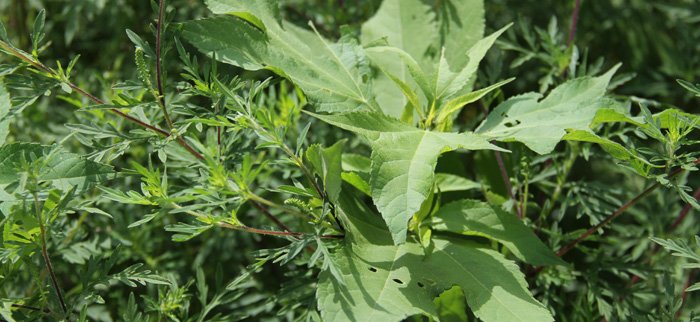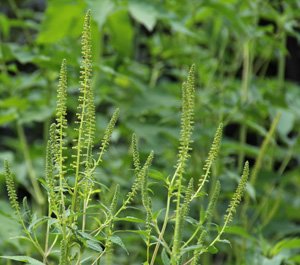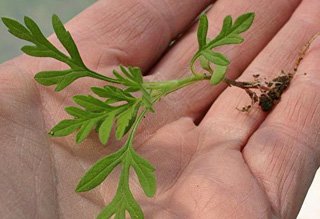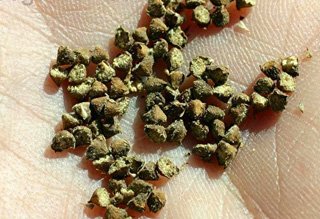





Do you wake up with red, itchy eyes these days? Are you in a constant state of sniffles and sneezes? Welcome to ragweed season!
 As autumn approaches, a number of plants get blamed for the symptoms caused by ragweed. The plant with the worst reputation and least guilt is usually goldenrod. Don't blame it for your woes, goldenrod's pollen isn't airborne. It is the sneaky ragweed that creeps into everything and starts the misery.
As autumn approaches, a number of plants get blamed for the symptoms caused by ragweed. The plant with the worst reputation and least guilt is usually goldenrod. Don't blame it for your woes, goldenrod's pollen isn't airborne. It is the sneaky ragweed that creeps into everything and starts the misery.
Most ragweeds are in the Ambrosia genus and the two that cause the most trouble in my southeastern US area are Ambrosia artemisiifolia, common ragweed and Ambrosia trifida, great ragweed. They start to bloom in late July/early August and they wreck havoc among allergy sufferers for months. However, in the US alone, there are at least 17 different species of ragweed, so chances are, no matter where you live, there's a special ragweed growing just for you.
 For some reason, the human body has an extreme dislike for ragweed pollen. At the first sniff, the body starts producing antibodies, which makes your system flood histamines into the bloodstream. Histamines cause the fearsome allergy symptoms that hay fever suffers know and dread. That's why the recommended treatments for allergies are called anti-histamines...they block histamine-producing biochemical reactions that your body activates when allergies go into overload. It is an ongoing few months of misery until frost kills the offending plants.
For some reason, the human body has an extreme dislike for ragweed pollen. At the first sniff, the body starts producing antibodies, which makes your system flood histamines into the bloodstream. Histamines cause the fearsome allergy symptoms that hay fever suffers know and dread. That's why the recommended treatments for allergies are called anti-histamines...they block histamine-producing biochemical reactions that your body activates when allergies go into overload. It is an ongoing few months of misery until frost kills the offending plants.
Many gardeners work hard to eliminate ragweed plants from their property edges and surrounding areas. It is a weed that prefers disturbed areas and often grows in great masses in abandoned lots and at the borders of agricultural areas. This is all well and good, however ragweed pollen is so light and fluffy that it can travel great distances. It has been measured as far as 2 miles up into the atmosphere and as far away as 400 miles off the coast in the ocean, so there is no running away from ragweed. Many gardeners resort to chemical control, however this is such a tough and hardy weed that many commercial herbicides have little or no effect on it. They usually present more of a threat to the environment than to the ragweed.
 To minimize the effects of the pollen, gardeners should remember to shower as soon as they finish gardening activities and even if they haven't been active outdoors, shower before turning into bed for the night. You don't want to sleep in pollen-crusted sheets...ewwww! Also, launder all gardening clothes immediately and don't shake them in the house to prevent the spread of the lightweight pollen.
To minimize the effects of the pollen, gardeners should remember to shower as soon as they finish gardening activities and even if they haven't been active outdoors, shower before turning into bed for the night. You don't want to sleep in pollen-crusted sheets...ewwww! Also, launder all gardening clothes immediately and don't shake them in the house to prevent the spread of the lightweight pollen.
Young ragweed plants should be eliminated as soon as they sprout. They grow very quickly into impressive weeds and the woody stems are hard to chop at that point. So get them while they are babies. Your back will thank you.
 For all of its unfriendly habits, ragweed is surprisingly edible. Yes, you can eat ragweed and it is actually good for you. There's evidence that Native Americans actually planted it and harvested the seeds. The seeds have an amazing percentage of crude protein (47%) and rivals corn, wheat and soybean in usable calories. This would have been an important food source for both human and wildlife during long winters. A nutritious oil was also produced by crushing the seeds, boiling them in water and skimming the resulting oil from the top. Fats are an important part of any diet and early peoples had scant resources for obtaining them.
For all of its unfriendly habits, ragweed is surprisingly edible. Yes, you can eat ragweed and it is actually good for you. There's evidence that Native Americans actually planted it and harvested the seeds. The seeds have an amazing percentage of crude protein (47%) and rivals corn, wheat and soybean in usable calories. This would have been an important food source for both human and wildlife during long winters. A nutritious oil was also produced by crushing the seeds, boiling them in water and skimming the resulting oil from the top. Fats are an important part of any diet and early peoples had scant resources for obtaining them.
While we despise it and seek to destroy it, ragweed was once an important part of early foodways, so as you're chopping it back, remember that it was once a useful plant and may be again in the future if disaster strikes.
Copyright © www.100flowers.win Botanic Garden All Rights Reserved